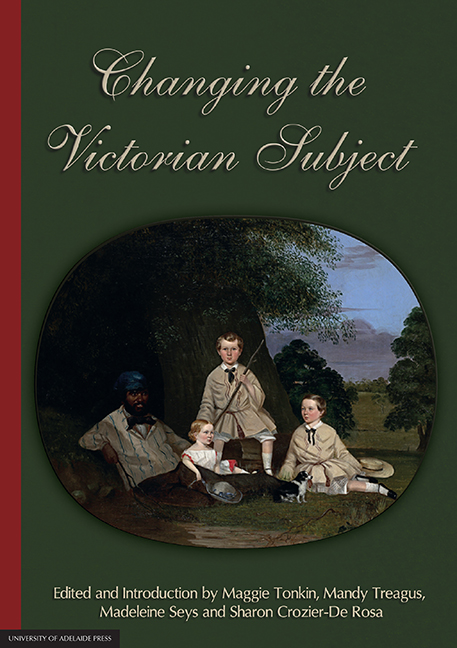Book contents
- Frontmatter
- Contents
- Notes on Contributors
- 1 Re-visiting the Victorian subject
- 2 Queen Victoria's Aboriginal subjects: a late colonial Australian case study
- 3 Identifying with the frontier: Federation New Woman, Nation and Empire
- 4 A ‘Tigress’ in the Paradise of Dissent: Kooroona critiques the foundational colonial story
- 5 The making of Barbara Baynton
- 6 A literary fortune
- 7 Olive Schreiner's From Man to Man and ‘the copy within’
- 8 Guy Boothby's ‘Bid for Fortune’: constructing an Anglo-Australian colonial identity for the fin-de-siècle London literary marketplace
- 9 The scenery and dresses of her dreams: reading and reflecting (on) the Victorian heroine in M.E. Braddon's The Doctor's Wife
- 10 The woman artist and narrative ends in late-Victorian writing
- 11 Miss Wade's torment: the perverse construction of same-sex desire in Little Dorrit
- 12 ‘All the world is blind’: unveiling same-sex desire in the poetry of Amy Levy
- 13 From ‘Peter Panic’ to proto-Modernism: the case of J.M. Barrie
10 - The woman artist and narrative ends in late-Victorian writing
Published online by Cambridge University Press: 05 December 2014
- Frontmatter
- Contents
- Notes on Contributors
- 1 Re-visiting the Victorian subject
- 2 Queen Victoria's Aboriginal subjects: a late colonial Australian case study
- 3 Identifying with the frontier: Federation New Woman, Nation and Empire
- 4 A ‘Tigress’ in the Paradise of Dissent: Kooroona critiques the foundational colonial story
- 5 The making of Barbara Baynton
- 6 A literary fortune
- 7 Olive Schreiner's From Man to Man and ‘the copy within’
- 8 Guy Boothby's ‘Bid for Fortune’: constructing an Anglo-Australian colonial identity for the fin-de-siècle London literary marketplace
- 9 The scenery and dresses of her dreams: reading and reflecting (on) the Victorian heroine in M.E. Braddon's The Doctor's Wife
- 10 The woman artist and narrative ends in late-Victorian writing
- 11 Miss Wade's torment: the perverse construction of same-sex desire in Little Dorrit
- 12 ‘All the world is blind’: unveiling same-sex desire in the poetry of Amy Levy
- 13 From ‘Peter Panic’ to proto-Modernism: the case of J.M. Barrie
Summary
The character of Elfrida in Sara Jeannette Duncan's A Daughter of Today is a representation of a figure increasingly seen in late-Victorian writing: the woman artist. The novel is a Künstlerroman, a significant form for the period, not only for the new narrative possibilities it seems to provide for female characters, but also because of its prominence in the rise of Modernism (Pykett 135). A Daughter of Today is one of the earliest examples of the form to feature the artistic development of a female protagonist, but it goes further than others in its exploration of new subjectivities for the heroine. Not only does the novel feature Elfrida's development as an artist, but it also depicts her as a confirmed egoist, preoccupied above all with her own development as both woman and as artist. This requires an abandonment of the dominant mode of being depicted in most nineteenth-century heroines, at least those endorsed by their narrators. Even in fiction in which the passion of the protagonist utterly drives the plot, most heroines are constrained by a finely tuned conscience and sense of duty that dominates their own desires for vocation, romantic fulfilment or both. This sense of self-sacrificing duty does not guarantee fulfilling fictional ends for such heroines, though, even when their narrators position readers to side with them. In A Daughter of Today, however, there is no such sense of sublimation or submission of self.
- Type
- Chapter
- Information
- Changing the Victorian Subject , pp. 201 - 216Publisher: The University of Adelaide PressPrint publication year: 2014



